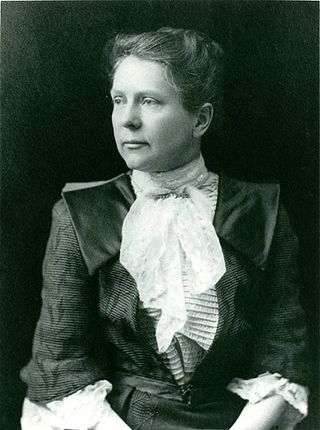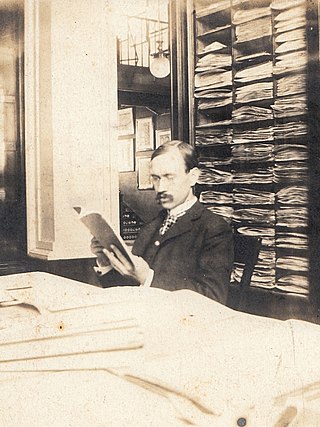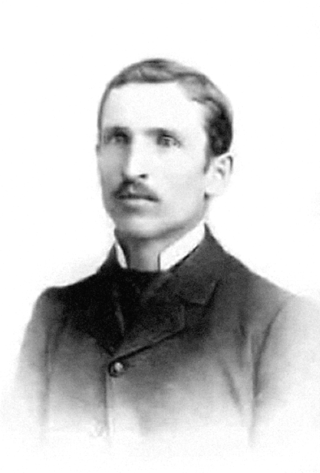
Bryology is the branch of botany concerned with the scientific study of bryophytes. Bryologists are people who have an active interest in observing, recording, classifying or researching bryophytes. The field is often studied along with lichenology due to the similar appearance and ecological niche of the two organisms, even though bryophytes and lichens are not classified in the same kingdom.

Annie Morrill Smith was an American botanist and bryologist from Brooklyn. She was a largely self-taught scientist, and became an important member of the Sullivant Moss Society. From 1906 to 1911 she acted as the sole editor of The Bryologist. She also published a number of important genealogical books.

Ceratodon purpureus is a dioicous moss with a color ranging from yellow-green to red. The height amounts to 3 centimeters. It is found worldwide, mainly in urban areas and next to roads on dry sand soils. It can grow in a very wide variety of habitats, from polluted highway shoulders and mine tailings to areas recently denuded by wildfire to the bright slopes of Antarctica. Its common names include redshank, purple forkmoss, ceratodon moss, fire moss, and purple horn toothed moss.

The American Bryological and Lichenological Society is an organization devoted to the scientific study of all aspects of the biology of bryophytes and lichen-forming fungi and is one of the nation's oldest botanical organizations. It was originally known as the Sullivant Moss Society, named after William Starling Sullivant. The Society publishes a quarterly journal distributed worldwide, The Bryologist, which includes articles on all aspects of the biology of mosses, hornworts, liverworts and lichens. The Society also publishes the quarterly journal Evansia, which is intended for both amateurs and professionals in bryology and lichenology and is focused on North America.

Jules Cardot was a French botanist and bryologist considered in his time one of the world's leading experts on the mosses of Antarctica.

Elizabeth Gertrude Britton was an American botanist, bryologist, and educator. She and her husband, Nathaniel Lord Britton, played a significant role in the fundraising and creation of the New York Botanical Garden. She was a co-founder of the precursor body to the American Bryological and Lichenological Society. She was an activist for the protection of wildflowers, inspiring local chapter activities and the passage of legislation. Elizabeth Britton made major contributions to the literature of mosses, publishing 170 papers in that field.

Clara Eaton Cummings was an American cryptogamic botanist and Hunnewell Professor of Cryptogamic Botany at Wellesley College in Massachusetts.

George Elwood Nichols (1882–1939) was a botanist, bryologist, algologist and ecologist, one of the founders of the Ecological Society of America. The standard author abbreviation Nichols is used to indicate this person as the author when citing a botanical name.
Elva Lawton was an American botanist and bryologist known for her research on ferns early in her career and her late-career comprehensive study of the mosses of the Western United States.

Carolyn Wilson Harris was vice president of the Sullivant Moss Society during 1904–1905 and charge of the Lichen Department from 1901 to 1905. She also wrote many articles on various lichen genera and species. She was known for being an indefatigable worker, and did much to popularize the study of lichens; her help was always given freely and cheerfully to those who applied to her for assistance in their studies.
Inez Maria Haring was an American botanist and plant collector, best known for her work in bryology as the Assistant Honorary Curator of Mosses at the New York Botanical Garden beginning in 1945.

Abel Joel Grout (1867–1947) was an American bryologist, an expert on pleurocarpous mosses, and founding member of the Sullivant Moss Society.

George Newton Best was an American bryologist, expert on moss taxonomy, and second president of the Sullivant Moss Society.

John Michael Holzinger was a German-born American bryologist, expert on the bryoflora of Colorado, and third president of the Sullivant Moss Society.
Stanley Adair Cain was a botanist and pioneer of plant ecology and environmental studies.
Albert LeRoy Andrews (1878–1961) was a professor of Germanic philology and an avocational bryologist, known as "one of the world’s foremost bryologists and the American authority on Sphagnaceae." From 1922 to 1923 he was the president of the Sullivant Moss Society, renamed in 1970 the American Bryological and Lichenological Society.
Dale Hadley Vitt is an American bryologist and peatland ecologist, recognized as a leading expert on peatlands. From 1989 to 1991 he was the president of the American Bryological and Lichenological Society.
Paul Leslie Redfearn Jr. (1926–2018) was an American professor of botany, specializing in mosses and liverworts. He was the president of the American Bryological and Lichenological Society from 1971 to 1973. He was the mayor of Springfield, Missouri from 1978 to 1981.
Bestia is a genus of mosses belonging to the family Lembophyllaceae.
Lincoln Ware Riddle was an American botanist who specialized in the study of lichens. Born and educated in Massachusetts, Riddle made significant contributions to lichenology, leveraging extensive scientific collections at Wellesley College and Harvard University. Throughout his career, he held esteemed positions at both institutions and was actively involved in botanical societies and editorial boards. His untimely death at the age of 40 left a notable void in the botanical community, but his impact remains, marked by various publications and honors.











